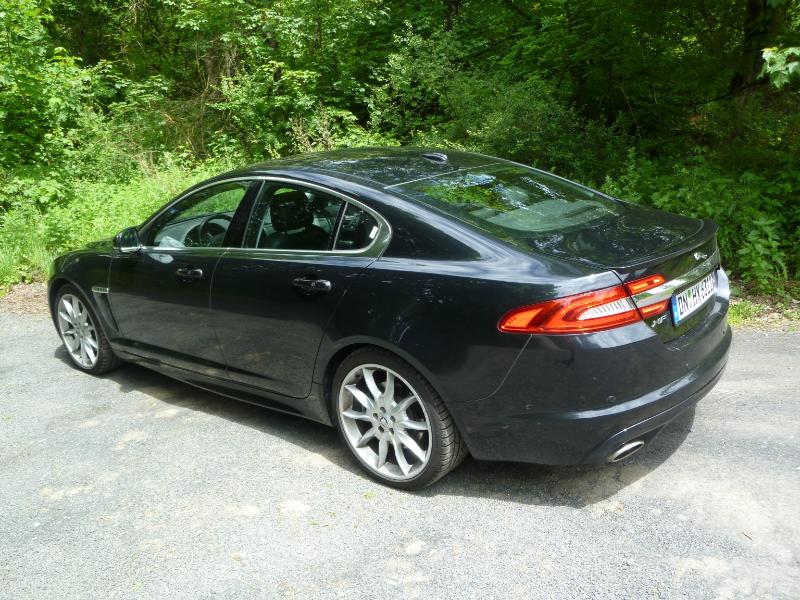



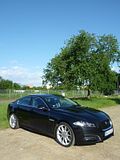


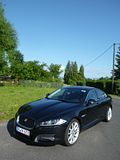


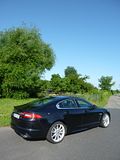
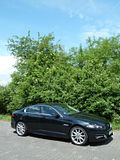
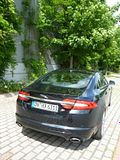

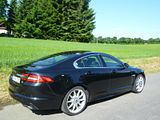
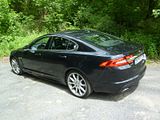

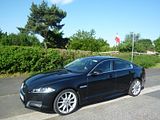
Whilst it is probably true that Jaguar’s first attempt in recent times to offer a mid-sized executive saloon car to take on the might of the German trio of 5 series, E class and A6, the S Type was not that brilliant a car when it first appeared. A program of continuous improvements transformed the vehicle during its life-cycle with the result that later model cars were actually pretty accomplished. And yet, the critics continued to moan that it was not up to the mark, citing the retro-inspired styling as a significant drawback. Stung by this criticism, Jaguar decided that the next generation of car, indeed the next generation of Jaguars as a whole would need to sever all links with the past, and this was evidenced when the C-XF concept vehicle was premiered at the Detroit Auto Show in January 2007. Every time that this very different looking Jaguar was shown during the year, opinions seemed equally divided between those who loved the new look and those who thought it simply did not look like a Jaguar any more. Whatever one thought of the production XF which first appeared at the Frankfurt Show in September 2007 and on sale in early 2008, it was clear that the engineers had done a first class job, as the early reviews from an often critical press were effusive in their praise. XF quickly accumulated an enviable tally of automotive awards including What Car’s “Car of the Year” 2008 accolade. The car promised much and looked like the beginnings of a real renaissance for Jaguar. These days product development moves at a pace, so it was not long before the first significant revisions appeared, with a completely new range of engines arriving in early 2009 to replace the first units. In April 2011 the first modifications were made to the bodywork, changing the front end to make it look more like the new XJ saloon. Still the awards continue to be made, with What Car continuing to declare the XF to be their Executive Car of the Year and there have been some very strong showings in the annual JD Power surveys. And yet, the market clearly struggles to recognise the merit of the XF, as in the first quarter of 2012 in Europe, BMW sold 31,961 5 Series, Audi shifted 29.,970 A6 models and 28,433 E Class Mercedes found buyers, compared to just 5,731 Jaguar XF cars. Intrigued as to why this should be, I have long wanted to sample an XF for myself, so when Hertz continued their policy of supplying me with a nice upgrade to the car I booked on a recent trip to Germany, and I found an Amethyst Black metallic XF waiting for me, I seized my chance to find out for myself just what the XF has to offer.
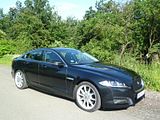

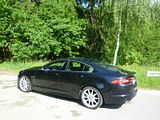
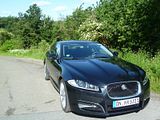
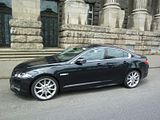

The test car was a 3.0D S model, which means it was fitted with the more powerful of the two 6 cylinder 3 litre diesel engines available in the XF, with 275 bhp rather than 240 bhp on offer. More importantly, there is a useful 442 lb/ft (600 NM) of torque available. What really impressed was that no matter what speed you were doing, and which gear you were in (and 7 are available), flex your right foot just a little and the car would really rocket forward. Seven forward ratios mean that there are enough to have several that really reduce the revs at a steady speed cruise. At 130 km/h (81 mph), in seventh, the engine was spinning at just 1700rpm. However, lest you fear that this would deprive the car of any acceleration, let me allay your fears, as even without changing down, the car would gather speed at an impressive rate. Although the engine is a strong point of the car, it is not perfect. At start up, you are still just about aware that this is a diesel, as it is not quite as whisper quiet as the legendary Jaguars of yore, and at lower speeds there are times when there is a slightly intrusive note, but overall I had to conclude that this is one of the (many) strong assets of this car. It is economical, too, as I averaged 39.7 mpg over a 700 km test distance. The XF was the first car with the cylindrical gearknob which rises out of the centre console when the engine is fired, and although some have said that this is a bit of a styling gimmick, I found that rotating the knob from Park either one position to reverse, or three to drive was if anything easier than the more traditional sort of lever that you pull backwards in some cases negotiating a gate. There is a sport setting as well, to the right of drive, and you have to press the knob down slightly for this. Paddle shifts are fitted behind the steering wheel as a further option. The gearchange itself is smooth, with absolutely no evidence of the changes in the higher ratios and just slightly more of a clue if accelerating hard in the lower ratios. The good news does not stop there. Not only is the leather clad steering wheel nice to hold, but the steering itself is good, with plenty of feel, which adds a bit more weight as you apply more lock. The good news about the dynamics continues with the roadholding and handling, both of which I thought were very good, with none of the alarm on wet roads that I experienced with the BMW 530d, and despite the fact that the test car sported 20″ wheels, the ride was also excellent. Overall noise levels were very low, with minimal sounds from the engine, the tyres or the wind when on the autobahn. Finishing off the dynamic excellence are the brakes, which also proved well up to the task that is expected of them. Visibility is not an issue, and the all-round parking sensors gave plenty of audible warning long before any trouble was likely to ensue. A reversing camera gave a very clear view of what was behind, projected onto the satellite navigation screen.
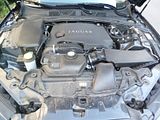
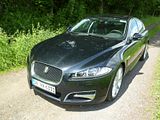
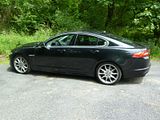
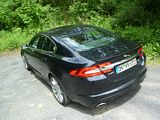
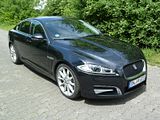
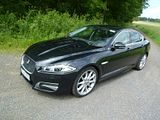
The interior of the XF is beautifully presented. You can tell that as soon as you open the door and look at it, but get in and touch the material and a feeling of the highest quality is very evident. In keeping with the perceived need to modernise the Jaguar, there is none of the traditional wood veneer in sight. The top of the dashboard is leather clad, and the front face uses a sort of milled aluminium look which manages to look restrained and classy. Although there are a lot of functions and settings offered, the interior manages to look far less cluttered than the insides of the German trio, with fewer buttons. Take the centre console, for instance. As well as the gear knob that sits flush with the console when the ignition is off, there are only a handful of other switches here, along with the “Start Engine” button, and the electronic handbrake, leading to a nice clean look. The instrument binnacle in front of the driver contains three dials, for speed, revs and a fuel gauge, with additional information imparted by warning lights and a display from the on-board computer. Chunky column stalks operate the indicators, wipers and by twisting the end of the indicator stalk, the lights. Centre of the dash contains a modestly sized display screen for the satellite navigation, and this is also used to change setting for the audio system, and all the other functions that you need occasionally. It uses a touch sensitive screen, which seems to me to be a much easier interface than iDrive or MMI. There are some additional buttons for the audio unit below this, and lower again than that are the climate control settings. Apart from a couple of other switches for things like fog lights, and some repeater functions for the audio system and cruise control which are mounted on the steering wheel boss, that is it. All very easy to use, and everything feeling to be of supreme quality.

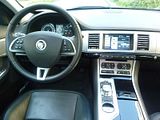
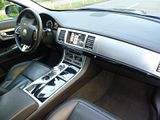
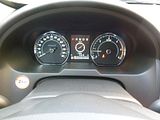


Although cars like the XF are typically a company acquisition and likely to accrue many of their miles with just the driver on board, the owner is quite likely to need to be able to accommodate colleagues during the working week, and a family out of working hours, so room inside the car is important. Here is where the Jaguar is perhaps not quite as convincing as the German rivals. Thanks to the sloping roofline, rear headroom is a bit tight, although my head did not quite touch the headlining. The amount of legroom available will depend on the position of the front seat. If it is set well back, it is in short supply and there is not a particularly generous area under the base of the seat for your feet either. Set the front seat for someone of my proportions and there is no issue at all. There is a transmission tunnel to contend with, which means that a third occupant in the middle of the back seat would need to sit with their legs slightly astride. Two rear seat passengers would be a far more comfortable experience than three. The boot of the XF is smaller than that in the German rivals, too. It is still of a decent size, but they all have gargantuan luggage spaces. It is of a regular shape, and you could tuck a few odds and ends under the floor around the space-saver spare wheel well. Inside the cabin there are some fairly narrow door pockets, a reasonable glove box, and a cubby under the central armrest.
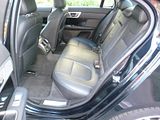


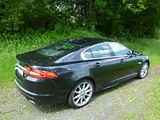
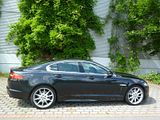
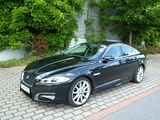
In the UK, Jaguar sell the 3.0D S model in three trim levels, Premium, Luxury and Portfolio, which cost £41,855, £46,105 and £49,005 respectively. A number of option packs and individual items are available to allow you to personalise your XF, at the risk of potentially adding significantly to the cost. In Germany it would seem that a single 3.0D S model is offered with a list price of €53,900. For that price you get a car that is generously equipped. All models come with a leather interior, with cloth not even an option. In addition, features that I noted on the test car included a large electric glass sun roof, dual zone climate control with additional control settings for those in the back. a fully integrated sat nav with touch sensitive screen, a DAB digital radio with bluetooth and auxiliary connections, all round parking sensors and reversing camera. There is an electric motor to close the boot, and further motors are used for adjustment for the steering column. There are two memory settings for the driver’s seat.

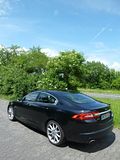
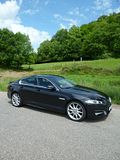
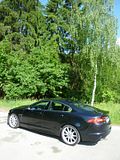


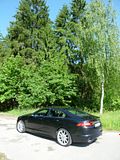
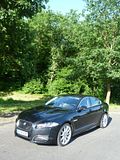
Be in no doubt that I enjoyed my time with the XF very much. It is a very accomplished car, with no significant weaknesses. So, why is it not selling in far greater quantities? Is it because buyers in this class are so fixated on one of the German trio that they just want their preferred model on the drive come what may and they never even give the XF a second thought? I doubt it. Is it because there are people with long and out of date memories who worry about the reliability issues that dogged Jaguar in the 1970s, 1980s and 1990s? If so, then they really are mis-informed, as data such as the annual JD Power surveys should demonstrate that with a place in the top 3 of all cars in recent years, XF drivers are not only delighted with their cars but also have an ownership experience that far surpasses the BMW, Audi and Mercedes. Of course, you could turn the question and ask your author of this article if he was so impressed by the Jaguar why he recently went and bought an Audi. Well, let me declare that if my company fleet policy had allowed me an XFR, I’d have found a way to afford it and that car would for sure be on my drive right now. But the sad reality is that I could not have one, as its emissions rating exceed our company limit of 250 g/km. And it is emissions performance which could explain the XF’s sales woes. The reality is that most cars of this class are company purchases in the UK and it is the tax efficient 4 cylinder diesels that generate the sales volume. Only recently have Jaguar introduced a 2.2 litre 4 cylinder model. Even when comparing the 6 cylinder diesels, it is clear that Jaguar have a problem. Whilst the 159 g/km CO2 of the test car is pretty impressive, it falls some way short of the figures delivered by BMW, Audi and Mercedes, and this means that the tax liabilities for the car make it notably more expensive than its German rivals. For too many people that is the deal-breaker. If only Jaguar could further reduce the emissions, but leave everything else alone, they really would have a world beater. Until then, if you can afford the costs of buying and running this car, I have to say I am sure you will be delighted with it. It is a very impressive machine indeed.
2012-07-04 06:14:59


















































